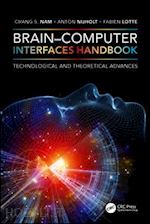Introduction: Evolution of Brain–Computer Interfaces [Fabien Lotte, Chang S. Nam, and Anton Nijholt] Part I Brain–Computer Interface Applications Section A Brain–Computer Interfaces Introduction Chapter 1 Brain–Computer Interface: An Emerging Interaction Technology [Chang S. Nam, Inchul Choi, Amy Wadeson, and Mincheol Whang] Chapter 2 Facilitating the Integration of Modern Neuroscience into Noninvasive BCIs [Mark Wronkiewicz, Eric Larson, and Adrian K.C. Lee] Chapter 3 Passive Brain–Computer Interfaces: A Perspective on Increased Interactivity [Laurens R. Krol, Lena M. Andreessen, and Thorsten O. Zander] Section B Therapeutic Applications Chapter 4 Brain–Computer Interfaces for Motor Rehabilitation, Assessment of Consciousness, and Communication [Christoph Guger, Rossella Spataro, Jitka Annen, Rupert Ortner, Danut Irimia, Brendan Allison, Vincenzo La Bella, Woosang Cho, Günter Edlinger, and Steven Laureys] Chapter 5 Therapeutic Applications of BCI Technologies [Dennis J. McFarland] Chapter 6 Neuroprosthetics: Past, Present, and Future [Stuart Mason Dambrot] Chapter 7 Design and Customization of SSVEP-Based BCI Applications Aimed for Elderly People [Piotr Stawicki, Felix Gembler, and Ivan Volosyak] Section C Affective and Artistic Brain–Computer Interfaces Chapter 8 Affective Brain–Computer Interfacing and Methods for Affective State Detection [Ian Daly] Chapter 9 Toward Practical BCI Solutions for Entertainment and Art Performance [Paruthi Pradhapan, Ulf Großekathöfer, Giuseppina Schiavone, Bernard Grundlehner, and Vojkan Mihajlovic] Chapter 10 BCI for Music Making: Then, Now, and Next [Duncan A.H. Williams and Eduardo R. Miranda] Section D BCI Control of Entertainment and Multimedia Chapter 11 BCI and Games: Playful, Experience-Oriented Learning by Vivid Feedback? [Silvia E. Kober, Manuel Ninaus, Elisabeth V.C. Friedrich, and Reinhold Scherer] Chapter 12 Brain–Computer Interfaces for Mediating Interaction in Virtual and Augmented Reality [Josef Faller, Neil Weiss, Nicholas Waytowich, and Paul Sajda] Chapter 13 Brain–Computer Interfaces and Haptics: A Literature Review [Jan B.F. van Erp] Part II Signal Acquisition and Open Source Platform in BCI Chapter 14 Utilizing Subdermal Electrodes as a Noninvasive Alternative for Motor-Based BCIs [Melissa M. Smith, Jared D. Olson, Felix Darvas, and Rajesh P.N. Rao] Chapter 15 Validation of Neurotrophic Electrode Long-Term Recordings in Human Cortex [Philip R. Kennedy, Dinal S. Andreasen, Jess Bartels, Princewill Ehirim, Edward Joe Wright, Steven Seibert, and Andre Joel Cervantes] Chapter 16 ECoG-Based BCIs [Aysegul Gunduz and Gerwin Schalk] Chapter 17 BCI Software [Peter Brunner and Gerwin Schalk] Part III Signal Processing, Feature Extraction, and Classification in BCI Chapter 18 Gentle Introduction to Signal Processing and Classification for Single-Trial EEG Analysis [Benjamin Blankertz] Chapter 19 Riemannian Classification for SSVEP-Based BCI: Offline versus Online Implementations [Sylvain Chevallier, Emmanuel K. Kalunga, Quentin Barthélemy, and Florian Yger] Chapter 20 The Fundamentals of Signal Processing for Evoked Potential BCIs: A Guided Tutorial [Garett D. Johnson and Dean J. Krusienski] Chapter 21 Bayesian Learning for EEG Analysis [Yu Zhang] Chapter 22 Transfer Learning for BCIs [Vinay Jayaram, Karl-Heinz Fiebig, Jan Peters, and Moritz Grosse-Wentrup] Part IV Brain–Computer Interface Paradigms Chapter 23 A Step-by-Step Tutorial for a Motor Imagery–Based BCI [Hohyun Cho, Minkyu Ahn, Moonyoung Kwon, and Sung Chan Jun] Chapter 24 Eye Gaze Collaboration with Brain–Computer Interfaces: Using Both Modalities for More Robust Interaction [Gaye Lightbody, Chris P. Brennan, Paul J. McCullagh, and Leo Galway] Chapter 25 Designing a BCI Stimulus Presentation Paradigm Using a Performance-Based Approach [Boyla O. Mainsah, Leslie M. Collins, and Chandra S. Throckmorton] Chapter 26 Issues and Challenges in Designing P300 and SSVEP Paradigms [Ali Haider and Reza Fazel-Rezai] Chapter 27 Hybrid Brain–Computer Interfaces and Their Applications [Jiahui Pan and Yuanqing Li] Chapter 28 Augmenting Attention with Brain–Computer Interfaces [Mehdi Ordikhani-Seyedlar and Mikhail A. Lebedev] Part V Human Factors, Design, and Evaluation in BCI Chapter 29 Toward Usability Evaluation for Brain–Computer Interfaces [Ilsun Rhiu, Yushin Lee, Inchul Choi, Myung Hwan Yun, and Chang S. Nam] Chapter 30 Why User-Centered Design Is Relevant for Brain–Computer Interfacing and How It Can Be Implemented in Study Protocols [Sonja C. Kleih and Andrea Kübler] Chapter 31 A Generic Framework for Adaptive EEG-Based BCI Training and Operation [Jelena Mladenovic, Jeremie Mattout, and Fabien Lotte] Chapter 32 Mind the Traps! Design Guidelines for Rigorous BCI Experiments [Camille Jeunet, Stefan Debener, Fabien Lotte, Jeremie Mattout, Reinhold Scherer, and Catharina Zich] Chapter 33 Evaluation and Performance Assessment of the Brain–Computer Interface System [Md Rakibul Mowla, Jane E. Huggins, and David E. Thompson] Part VI Emerging Issues and Future BCIs Chapter 34 Privacy and Ethics in Brain–Computer Interface Research [Eran Klein and Alan Rubel] Chapter 35 Associative Plasticity Induced by a Brain–Computer Interface Based on Movement-Related Cortical Potentials [Natalie Mrachacz-Kersting, Ning Jiang, Kim Dremstrup, and Dario Farina] Chapter 36 Past and Future of Multi-Mind Brain–Computer Interfaces [Davide Valeriani and Ana Matran-Fernandez] Chapter 37 Bidirectional Neural Interfaces [Mikhail A. Lebedev and Alexei Ossadtchi] Chapter 38 Perspectives on Brain–Computer Interfaces [Gerwin Schalk] Conclusion: Moving Forward in Brain–Computer Interfaces [Chang S. Nam, Fabien Lotte, and Anton Nijholt]












